Tennis Essentials for Beginners
Inspired by Wimbledon? Ready to get on the court? We have created this guide of tennis essentials to help you on your way to becoming a tennis maestro.
So you’ve decided to take on the magnificent sport of Tennis and you can’t wait to get started! But where do you start exactly? What beginner’s tennis tips should you keep in mind before stepping out onto the court for the first time? What are the must-haves in a beginner’s tennis essentials list? What to wear for tennis at all? In this post, you’ll learn all you need to make sure you’re prepped and ready for your first tennis lesson.
Your Tennis Essentials
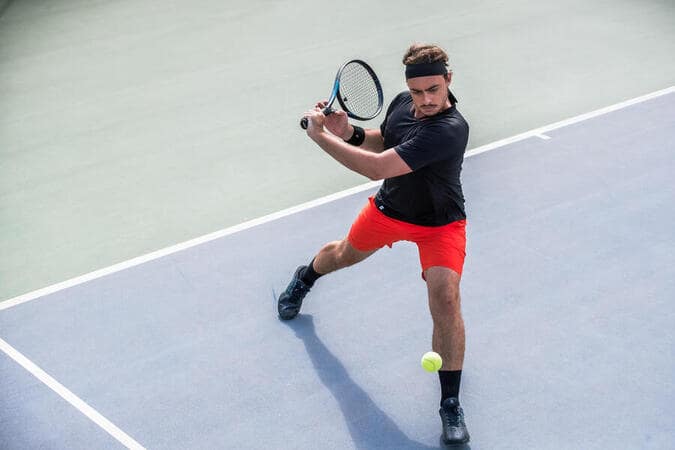
Find out what you need to make your first Tennis lesson count, from beginner tennis tips to your tennis bag essentials; get your know-how below, starting with the tools of the trade that you just can’t do without.
Tennis racket
Your number one tennis essential is a racket that suits your skill level. When choosing a tennis racket, there are three things to look out for; weight, size and grip.
Weight
For beginners, the key is to stay lightweight. This will allow you to have an easier time swinging your racket and you’ll be slower to tire. As you start out, your fitness and muscle stamina might not be at their peak and anything that can help you reduce fatigue can go a long way. With a beginner’s lightweight racket, you’ll be able to focus on practicing your technique without worrying too much about an onslaught of muscle cramps all too soon. Anything between 10 and 11.5 ounces can count as a beginner-friendly tennis racket.
Size
Opt for a bigger racket head size to increase your chances of making contact with the ball with a greater surface area to rely on — specifically the tennis racket sweet spot. The tennis sweet spot is the center spot of the racket you’ll want the ball to hit. Naturally, the bigger the sweet spot, the easier your aim. The larger head size is particularly useful if you haven’t perfected your strike or timing yet. Anything between 98 and 110 square inches is classed as a beginner’s racket and a great tool to support you through the initial stages.
Grip
Lastly, take note of your grip size which can vary a lot depending on your hand size. Getting the wrong size grip can tire your muscles and make precise stroke movement more difficult. By finding a racket to suit your grip size, you’ll be able to make use of a full range of motion, swing in comfort and decrease the likelihood of injury.
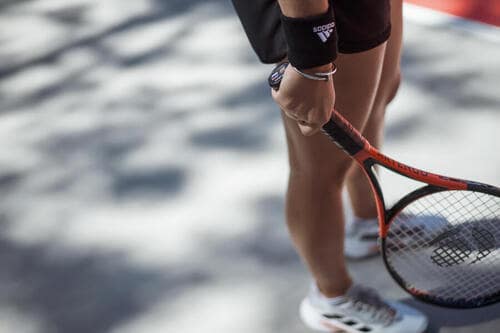
How to Choose Your Tennis Racket?
A Tennis Racket is a key tool for any Tennis player. But what’s the best one for you? Find out right here.There are few things more important than finding the perfect tennis racket. Your tennis racket is an important step in your tennis-playing journey, whether you're just starting out or have been playing for years. Find out how playing frequency and your playing preferences will come into play when making your choice.
What to consider
While it could seem like the best idea to buy the tennis racket with the coolest design and most vibrant colors, it’s better to initially focus on yourself instead of the racket. Considering factors such as your size, playing style and how often the tennis racket will be used, will make finding the perfect racket much easier.
Let’s have a look at the specifics.
Your size and strength. Everybody’s different, so of course, certain tennis rackets will suit your particular body type and strength. In general, the taller a person is, the longer their arms are and the longer their swing will be. This usually means the player will be able to generate more speed and power than someone with shorter arms and a smaller swing. When looking at tennis rackets, it’s generally accepted that the wider the frame, the more power you’ll get from your shot. This width is found just underneath the surface area, in the gap that is known as ‘the throat’ and is the area that has the most effect on the ball when you make contact. However, if you check out a professional's racket, they are rarely that wide, showing that the more you play, the less you should rely on your racket for power.
How often do you play, or plan to play? This is a question you could ask yourself over any piece of sporting equipment, especially with an integral instrument such as a tennis racket to make the most economical choice. While you should always be looking for the tennis racket that works best for you, there’s no need to invest in pricey gear when it's going to be used only a few times a month.
For an occasional player, your main focus should be control. By choosing an aluminum or composite racket with a large surface area and balance point, you'll make your time on the court much easier.
For someone that plays regularly, it’s important to feel comfortable. Look for a graphite racket with a balance point at the head and a surface area of 645cm². If as a regular player, control is something you want to improve, opt for a tennis racket weighing between 260 and 280g. If you want to introduce more power to your game, opt for a racket weighing between 280 and 295g.
See yourself as an intensive player? Power and precision should be at the forefront of your thinking. A graphite tennis racket with a balance point at the handle and a surface area of between 630 and 645cm², with a racket weight of more than 295g is the perfect pick for you.
Are you an aggressive or defensive tennis player? You may not have thought about it, but it’s rare that a player isn’t doesn't fall into one of these categories. Defensive players like to use the pace of the ball against their opponents, and in turn, should look for a narrower racket. If, on the other hand, you like to play aggressively and create power from your own shots, you’ll be wanting a racket that lets you hit the ball harder. While your playing style is important, it should never come ahead of what tennis racket works with your body shape
What’s your swing style like? If you don’t play regularly, it may be worth speaking to a tennis instructor or even visiting a Decathlon store and having a chat with one of our experts about your swing style. You will either have a slow, average or fast swing. Unsurprisingly, a faster swing generates more power than a slower swing, meaning you don’t need to look for a powerful racket if you have great speed; you should be looking for a narrower, more controlled racket instead.
Specifications
Weight
Weight plays a major role in the effectiveness of your swing and should be an important factor in the tennis racket you buy. It’s more than likely that you will be able to find the model of racket you like, suitable to your weight, so make sure to enquire about varying sizes with your chosen manufacturer. Heavier, more powerful rackets are around 320gs and beyond whereas lighter rackets weigh less than 310g. It’s also important to note that strings themselves will add around 30g to the racket.
Length
For adults, tennis rackets can be anywhere for 27-29 inches long, although it’s common for them to be on the lengthier sides. In general, longer rackets are lighter than the standard frame. They also offer more reach and power on serve, as you can hit the ball from higher up, and in turn, are able to steepen your angle when hitting downwards. However, longer rackets are harder to control so it’s worth trying them out before you buy one.
Head
The surface area of your racket is an important aspect to keep in mind. Below are the three types of surface area available and what they mean to you.
Racket With A Small Surface Area
When it comes to rackets, a small surface area means around 600cm². This surface area is aimed at intensive players. You need good control to play with these rackets as they’re harder to control.
Racket With A Medium Surface Area
Rackets with a medium surface area are usually between 630cm² and 645cm². They are suitable for all kinds of players, from beginners to seasoned players.
Racket With A Large Surface Area
Rackets with large surface areas vary between 660 and 740cm². Rackets with a large surface area are perfect for beginners or players who like to use lots of spin. These surface areas increase power.
How to Choose Your Tennis Shoes?
Picking your tennis shoes will depend on your level, the court surface and the comfort you're looking for. Here's our full list of tips.
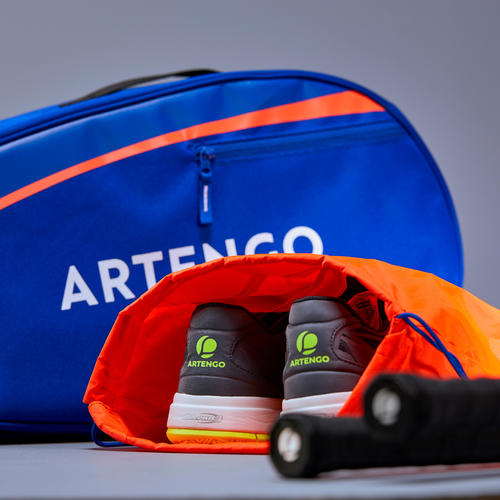
Our Racket Sports Brand
As a racket sports brand we have plenty of advice to help you with your game.
Choosing the best tennis shoes will depend on a number of things, such as the level you play at, the different types of court surfaces you practice on and also the technical features of the products.
1.Playing Level
Artengo offers three types of shoes depending on your skill level:
For Occasional Use:
If you make it out to play on a less than regular basis, go for comfortable shoes such as the 700 Series ones.
For Regular Use
If your playing frequency is average, you should look for better cushioning in order to protect your joints. For enhanced cushioning, go for the 800 Series.
For Intensive Use
Designed for highly intense sessions, go for the 900 Series if you are looking for optimal comfort coupled with good durability.
2. The Different Types Of Court Surfaces
The court surface you play on will also affect which tennis shoes are best for you. The difference will lie primarily in the sole.
- Choose a pair with good grip (look out for a chevron design on the sole) if you play on clay
- For hard courts go for high durability
- Finally, if you are only just taking up tennis, don't hesitate to head for the " all-surface " shoes, which will allow you to learn more about what suits you and build your confidence.
Tennis Shoes
What would tennis be without the perfectly-fitted tennis shoes to boast pure comfort on the court?
Tennis Shoes vs Running Shoes
Tennis shoes differ from your regular running shoes in a few ways; tennis shoes tend to be flat-soled, more durable and designed to withstand the dynamic movements unique to tennis. From the constant and harsh starting and stopping, pivoting and side-to-side movements, tennis sets itself apart from the challenges faced in running. Therefore, tennis trainers are designed to cater to just that using a variety of unique features including extra ankle support, heel cushioning and complex outsoles for additional grip.
Court Surface
Finding the right outsole is the most important tip to finding your fit, much of which is determined by the type of surface you’ll be playing on. The weight, speed and stability of the tennis shoes can vary, and there are a few considerations and trade-offs to be made based on your preferences.
We advise beginners to focus on extra stability to give you the support you need as you learn the ropes. This is because you’re unlikely to use high speeds and pivots as a rookie, and can always upgrade once you feel more comfortable and level up!
Outsoles for Different Surfaces
Outsoles are designed and optimized to suit different surfaces including grass, clay or hard surfaces. And where you’ll be playing will affect the kind of outsoles you should wear as they have a direct impact on your footwork. Get a breakdown of the three main Tennis outsoles below.
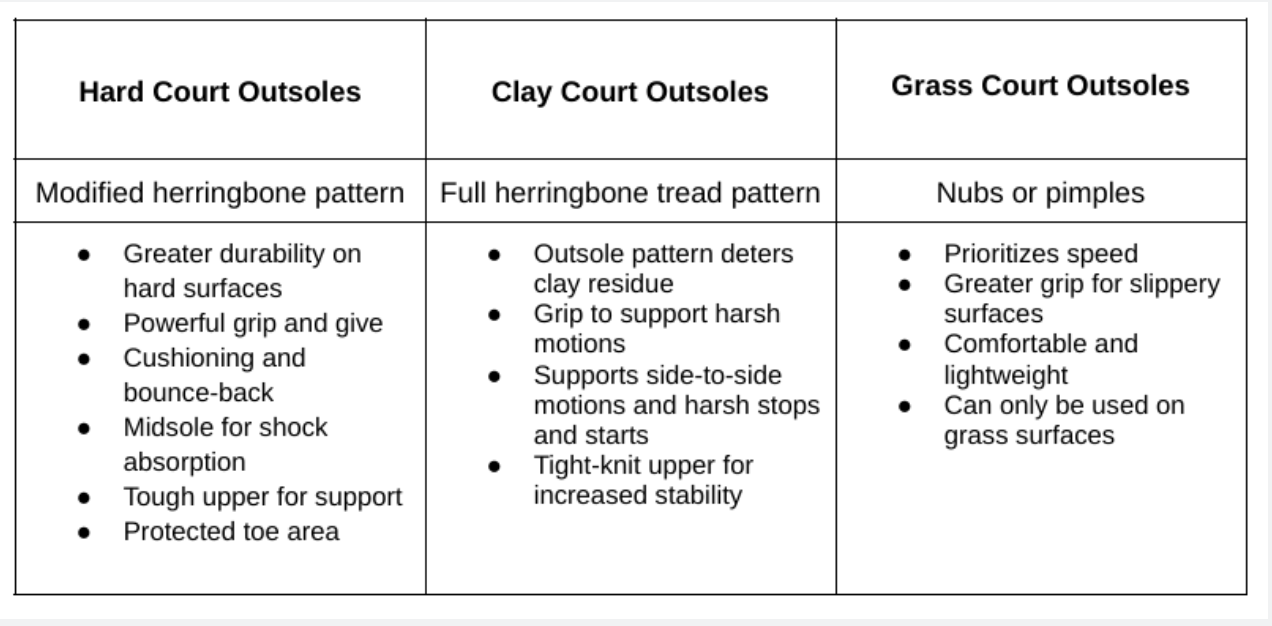
Determining your Foot Type
Your foot type indicates the different biomechanical needs your feet have. The height of your foot’s arch affects the way your foot rolls (also known as pronation). This occurs naturally as your feet hit the ground to absorb the shock. Your type of foot arch falls into one of the following three categories:
Neutral arch: where the foot lands on the outside of the heel and rolls inwards for healthy shock distribution. Low arch: where the foot rolls excessively inward, focusing the shock to the inner edge.
Determining your Foot Type
Your foot type indicates the different biomechanical needs your feet have. The height of your foot’s arch affects the way your foot rolls (also known as pronation). This occurs naturally as your feet hit the ground to absorb the shock. Your type of foot arch falls into one of the following three categories:
Neutral arch: where the foot lands on the outside of the heel and rolls inwards for healthy shock distribution.
Low arch: where the foot rolls excessively inward, focusing the shock to the inner edge.
High arch: where the outer side of your heel lands at an excessive angle with too little inward rolling.
To find out which foot type you fall under, take a look at the bottom of your trainers; the specific wear will indicate what foot type you’re likely to have. Check out the table below to find out what your wear says about your pronation and the kind of tennis shoe features you should prioritize to suit your specific foot type.

Playing Style
Your playing style depends on whether you’ll be playing as a baseline player or a serve-and-volley player.
Baseline payer: Usually positioned at the back of the tennis court, navigating around the baseline and usually focusing on groundstrokes. A durable sole will allow baseline players to keep up with the constant lateral motions while providing the stability needed for high-speed movements.
Serve-and-volley player: What to wear for tennis serve-and-volley-player is defined by their constant approaches towards the net after a serve to hit a volley. This means that the player tends to slide their back foot along the court during the serve where a durable toe cap (or reinforced toe) featuring an inside arch will provide the most support and comfort.
What do I need to wear for Tennis?
What are beginner’s tennis tips without a little guidance on what to wear for tennis?
Ultimately, there is no particular dress code if you’re playing on a public court and as long as your footwear is sorted (and your shoes aren’t going to damage the court), you’re set with the essentials listed above. But getting the right sportswear can make a huge difference in comfort and is worth considering even if you’re not planning to go pro anytime soon. If you’re joining a tennis club, however, you will have to stock up on recognizable tennis sportswear which means your go-to gym shorts and tees won’t make the cut.
Here’s what to look out for when choosing your tennis sportswear:
Allows for freedom of movement
Lightweight and comfortable
Made of moisture-wicking material (to absorb sweat)
You’ll find that the tennis-go-to outfit is a short-sleeved top made of cotton along with matching shorts or skirts. Why not check out the Decathlon range of tennis clothes for a little inspiration?
Tennis Beginner tips
Now that you’ve got your tennis bag essentials down, let’s move on to a few useful beginner’s tennis tips to make your first day on the court count.
1. Practice habitually - Tennis is a refined sport and consistency is key in ensuring you’re able to progress in technique and style. Having regular training sessions will give you plenty of opportunities to put theory into practice and refine your technique over the long haul.
2. Warm-up and cool down - A must after any strenuous exercise, take the proper precautions to make sure your body is ready for some intense rallies, ensuring effective recovery of your heart rate and blood pressure to avoid injury.
3. Stay hydrated - Tennis games can get intense and it’s easy to forget to stop and take a sip. Grab your water bottle and keep it topped up throughout your session and well after.
4. Improve your speed - Once you’ve nailed down the basics, you’ll find that speed in particular sets advanced players apart. Work on your reaction time and how to anticipate shots using jump rope exercises.
5. Learn different grips - Different shots require different grips; get the basics down first so you don’t need to unlearn habits further down the line.
6. Build your fitness - Tennis is a game of stamina and your ability to stay energized will make a huge difference. Go for aerobic workouts including running, HIIT workouts and cardio drills.
Have some fun!
Now that you have your beginner’s tennis tips and know exactly what to wear for your tennis lesson, decked out with your must-have tennis bag essentials, start to go score some points! And when in doubt, you can always brush up on the Rules of Tennis right here.
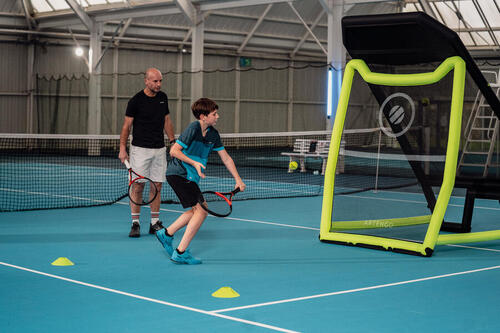
The Perfect Cardio Drills for Your Tennis Game
Cardio and other habits to get you in shape for this season of Tennis.
If you’re inspired by the power and beauty of Serena Williams or the speed and athleticism of Novak Djokovic, using these 5 tips will help you get the body of a tennis player. We’ll show you how to train and eat like a pro so you can whip your body into Wimbledon-worthy shape, even if you're not quite ready to play there!
1. Legs
Speed, agility and sheer strength are needed from a tennis player’s legs and you’ll need to work hard to get your conditioning up to snuff. One of the best ways to tone your legs is to skip. Rumors have it that Roger Federer kicks off his training sessions by skipping and so should you. Try to skip for one minute before resting. Repeat this between three and five times depending on your fitness levels. If you own a jump rope that’s also a great tool to up your fitness level.
Another great way to work your legs is to do some interval training. Serena Williams completes interval training as a part of her routine and if it works for her it will work for you. If you are running on a treadmill, begin by walking quickly for two minutes, then walk a little quicker on a steeper gradient for one minute before sprinting with no gradient for one minute. Repeat this process between three and five times. If you are working outside, use lampposts or a stopwatch to complete your session and time your intervals. Wind sprints are also a great cardio drill and it will remind you of gym class. You should also try to include some lunges with resistance and some lateral raises into your exercise routine to get legs like a Tennis player.
2. Diet
Diet and nutrition plays a key role in any pro-player’s performance. Although you might not have a dietician on hand or a personal chef, you can still eat like a Tennis player or try to!. One of the key food groups to focus on is carbs. During a match, a tennis player can lose typically between 500 to 1500 calories, so refueling using carbohydrates is essential. Try eating whole wheat pasta, brown rice, or cereals post-match. Take a page out of Rafael Nadal’s book and eat some grilled fish, alongside a portion of pasta and fresh vegetables. On those days when you’re not playing a game, you could start your day with a smoothie. Venus Williams eats vegetable-based smoothies, using kale, carrots, cucumber and protein powder to create a nutritious morning meal. For lunch, Venus likes to eat big salads with plenty of raw veg, beans and lentils. If you continue to eat this mix of protein, fruit and veg, fiber and carbohydrates you should be able to get the body and the speed of a Tennis player in no time.
3. Cross-Training
If you want to look and play like a pro-player you have to play tennis. Yet although the stars play daily for a couple of hours at a time, chances are you have other commitments, which means you can’t dedicate so much time to the court. And some of us play outdoors and that’s not always possible in places like the United Kingdom. However, just because you can’t dedicate as much time to tennis as the pros, doesn’t mean that when you train you should only play tennis. You still need to work out your body doing other forms of exercise. This is known as cross training. Cross-training is essential for any athlete, not only because it helps build and work other muscle groups (which in turn helps you to become a better tennis player), but it also helps to reduce the stress on the body and will reduce your risk of picking up a common tennis injury. Try to work some alternative training, such as cycling, crossfit, yoga or rock climbing. This will make you a better player and you’ll also have a flawless tennis body as a result.
4. Arms
If you want to have a serve clocking in the triple digits (the fastest ever serve on record is, according to the Guinness World Records, 163.7mph and was hit by Sam Groth in 2012) then you need to pay some serious attention to those Pythons! As well as playing tennis, you’ll need to do some decent strength training exercises too. Try to include a combination of exercises, such as straight-arm rowing, dips, chest presses, push-ups and medicine ball drills. These can be used as cardio warm-up before the match or on other days where you’re not playing tennis. In order to keep progressing and building muscle and tone in your arms you have to make sure you keep your training sessions varied. Look out for different cardio Tennis drills and games. Experiment with a range of different exercises and never fall into the trap of a training rut as your improvement will stagnate.
5. Posture
This is probably the hardest to explain and most important aspect of training. If you watch tennis players both off and on court they don’t slink about or slouch. They stand tall. They’re confident. Their shoulders are back, their hips are in line with their ears and boy don’t they look 10 times better for it. Remember that getting the body of a tennis player is not just about working out a lot and eating decent food, it’s also about your posture and your confidence too. To improve your posture, work your core by doing exercises like the plank. You can also strengthen your core by doing a Pilates class, just like John McEnroe, doing back extensions and performing exercises that work your obliques and your abdomen are well suited to this. This core work will also improve your balance and tone up your stomach, so there are lots of benefits to be gained by doing these exercises. Try to be conscious of your posture throughout the day and make sure you reposition your body and ensure your spine sits in an S shape when your posture begins to slip.
If you follow these tips and tricks you’ll be amazed at how much your game will improve. Happy training!













